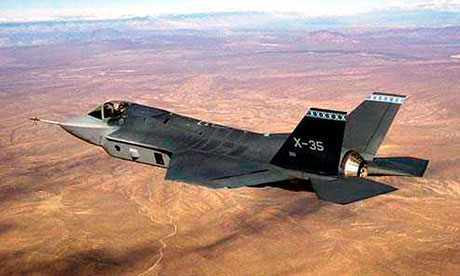Plan to spend $10bn on updating nuclear bombs goes against 2010 pledge not to deploy new weapons, say critics
courtesy: Guardian.co.uk

Barack Obama has been accused of reneging on his disarmament pledges after it emerged the administration was planning to spend billions on upgrading nuclear bombs stored in Europe to make the weapons more reliable and accurate.
Under the plan, nearly 200 B61 gravity bombs stockpiled in Belgium, the Netherlands, Germany, Italy and Turkey would be given new tail fins that would turn them into guided weapons that could be delivered by stealth F35 fighter-bombers.
“This will be a significant upgrade of the US nuclear capability in Europe,” said Hans Kristensen, a nuclear weapons expert at the Federation of Nuclear Scientists. “It flies directly in the face of the pledges Obama made in 2010 that he would not deploy new weapons.”
In its Nuclear Posture Review in 2010, the US undertook to do reduce the role and numbers of its nuclear weapons, in part by not developing new nuclear warheads, and pledging it would not “support new military missions or provide for new military capabilities”.
According to newly published budget figures, the US will spend about$10bn (£6.5bn) on a life extension programme for the B61 bombs, and another $1bn on adding controllable tail fins. Kristensen said the tail kit would give it a new mission and new capabilities, once some of the upgraded weapons were deployed as scheduled in Europe in 2019 or 2020.
“What will be going back to Europe will be a guided nuclear bomb,” he said. “Especially when you combine it with F35 with stealth characteristics, that expands the targets you can hold at risk from Europe, because by placing the explosion closer to the target you can choose a lower explosive yield. That is very important as there is less radioactive fallout. For many people this is a great concern because it means making nuclear weapons more ‘usable’.”
The new B61 Mk12 will be a 50 kilotonne weapon, like most of the “tactical” nuclear bombs currently in Europe. The bigger, strategic versions of the B61, stockpiled in the US, would be discontinued. Some European countries, led by Germany, have attempted to get the American B61 bombs withdrawn from Europe on the grounds they serve no military purpose following the end of the cold war and that they represent a security risk because of the possibility of their theft by terrorists. But some eastern European states have resisted their withdrawal, fearing it would show a weakening of US commitment to defend them against Russia.
US administration officials say the addition of tail fins to the bomb does not represent a significant change in its mission and therefore does not break the 2010 pledge. They insist that Obama remains committed to the disarmament agenda he outlined in a 2009 landmark speech in Prague, in which he promised to work towards a world free of nuclear weapons.
Since then, the US signed the new Start treaty with Russia, limiting both sides’ strategic arsenals to 1,550 deployed warheads each. This spring, Obama was expected to make a speech outlining proposals to make further cuts to about 1,100 warheads. But US officials have said the crisis over North Korea and the time needed to install a second-term national security team have delayed the speech.
Obama’s national security adviser, Tom Donilon, went to Moscow earlier this month to deliver a message from the president to his Russian counterpart, Vladimir Putin, which included proposals to cut the two countries’ nuclear arsenals and finding a compromise in the long-running dispute over US plans for a missile defence system in Europe. Sources familiar with the talks described the Russian response as positive. Obama and Putin are to meet at the G8 meeting at Lough Erne in Northern Ireland in June, but it is unclear whether the new nuclear weapons cuts will be ready by then.
Joseph Cirincione, the president of the Ploughshares Fund, an arms control pressure group, said the B61 modernisation plans were largely driven by domestic political considerations but risked sending mixed messages to Russia at a time when Washington and Moscow needed to strike a deal.
“I’m convinced the president wants to the continue his efforts to reform US nuclear policy,” Cirincione said. “But the administration had a schizoid approach on this issue. They believe they have to buy off legislators with billions of dollars in expenditure in their states in order to get votes for arms control measures later.
“The billions of dollars we are lavishing on the B61 is criminal. This is billions of dollars spent on a weapon whose mission evaporated at the end of the cold war. It’s clearly aimed at buying senators’ votes.”
